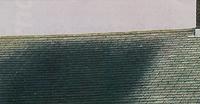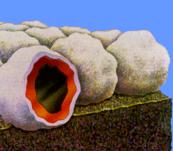Copper Blocks Ugly Bugs
 Composition roof shingles discolored by algae
Composition roof shingles discolored by algaeCopper blocks the growth of ugly, energy-robbing algae that invade roofing. To inhibit the airborne algae, gloeocapsa magma, which cause dark, heat-absorbing streaks on asphalt shingles, two manufacturers have developed systems for dispersing algae-preventing copper ions over shingles.
ISP Mineral Products, Inc., a division of International Specialty Products, Inc., Hagerstown, Maryland, and 3M Company, St. Paul, Minnesota, manufacture granules containing copper oxide. Roofing manufacturers attach the protective granules, made in a variety of colors, to the tops of their asphalt shingles.
Both ISP and 3M enclose copper oxide in ceramic to form the granules (see illustration). Moisture leaches ionic copper through the porous ceramic. The granules are guaranteed by 3M to dribble out copper for at least 10 years. David Little, director of sales for ISP, says tests show its granules will continue to provide copper for as long as 25 years.
The algae problem is particularly burdensome in damp areas like the Pacific Northwest, the Gulf Coast and the Southeastern states, but occurs nationwide. For instance, roofs of homes in Hudson, Wisconsin, near the St. Croix River, are afflicted.
Mike Conflitti of CertainTeed Corporation, Valley Forge, Pennsylvania, says his company guarantees the copper will block algae for as long as its shingles are guaranteed (some up to 30 years). Conflitti recommends that roofers use copper nails to install CertainTeed shingles made with the copper-bearing granules.
ISP and 3M don't agree on how much their granules add to the cost of roofing materials. 3M admits that its copper-bearing granules, "Algae Block Copper Roofing Granule System," can add $150 to $300 to the cost of a home's roof. However, ISP says roofing manufacturers don't charge any more for the shingles protected by ISP's "Algae Resistant Granules 900 System."
Even at an added cost, the copper-bearing granules are a bargain compared to the cost of cleaning every few years. if the black algae are not removed, there's evidence they increase the cost of heating and cooling, although no study of the energy losses has been conducted to date.
 Cutaway from 3M shows the reddish copper oxide encased in porous ceramic. Rain or dew penetrating the granules leaches out copper ions.
Cutaway from 3M shows the reddish copper oxide encased in porous ceramic. Rain or dew penetrating the granules leaches out copper ions.Algae can be removed by cleaning with strong, chlorine-based compounds. Some homeowners even spray bleach or swimming-pool solutions on their roofs. However, Ken Sanders, a technical representative with shingle manufacturer U.S. Intec, Inc., Port Arthur, Texas, says such cleaning, besides its repeated costs, is usually unsatisfactory because:
- Cleaning compounds tend to dry out and age the shingles;
- Even if a cleaner uses a long brush instead of walking on the roof, he often dislodges granules adhered to the shingles;
- Cleaning solutions may run off on shrubbery and damage it.
Granules bearing zinc oxide are also offered by ISP as a solution to the algae problem. Some shingle makers have also added metallic zinc granules to their products. However, a 3M spokesperson claims the metallic zinc granules are not only more expensive than 3M's copper oxide granules, but can also cause an unsightly "white rust."
3M Company: 800447-2914
ISP Mineral Products: 301733-4000
Also in this Issue:
- Copper Blocks Ugly Bugs
- For Fast, Even Cooking
- Copper "Fashionable" in Jewelry
- Copper Lightning Protection Systems Save Lives, Billions
- Copper and Brass Tokens Boost Business
